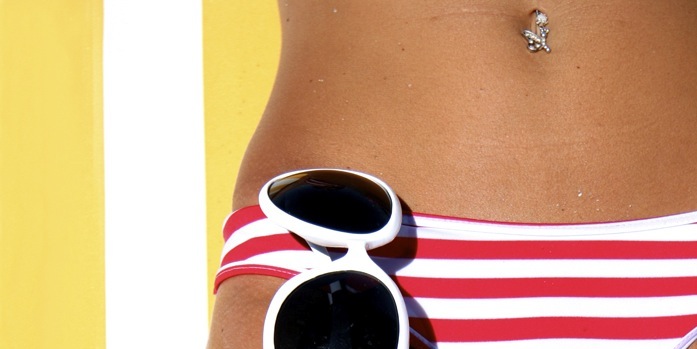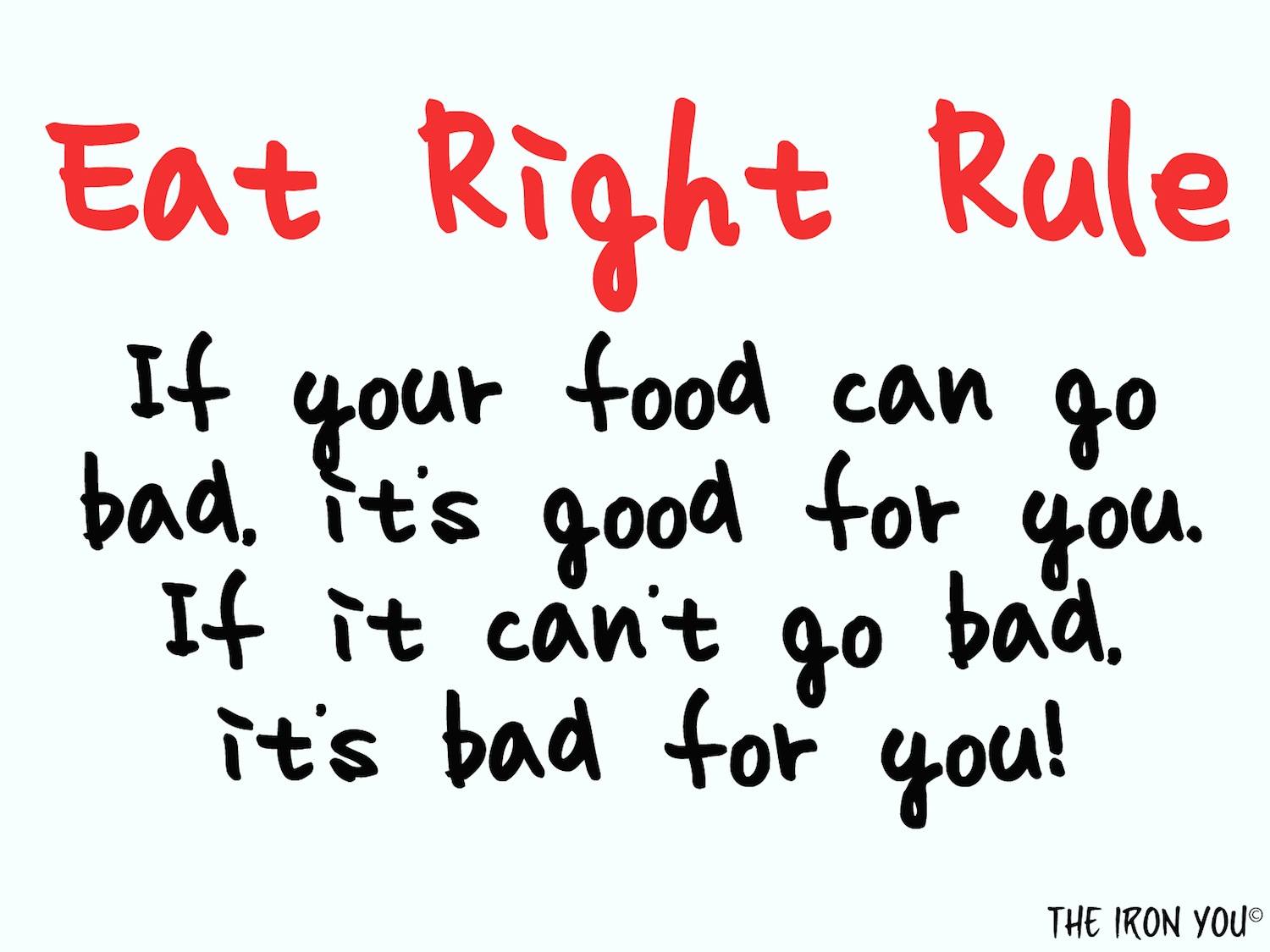As appealing as it sounds (and as much we would love for this to be true) spot reduction is, however, a misguided notion.
Is It Possible To Spot Reduce A Body Part Fat Content?
November 27, 2012
Spot reduction is the idea that if you work a specific muscle group you’ll be able to decrease the amount of fat in that area. As if there is a way to target one specific area of your body, such as your abs, your thighs, or even your bum and make all the fat disappear in that area just by doing one exercise.
As appealing as it sounds (and as much we would love for this to be true) spot reduction is, however, a misguided notion.

As appealing as it sounds (and as much we would love for this to be true) spot reduction is, however, a misguided notion.
November 25, 2012
All around us, everyone (including myself) is yelling about eat this, don’t eat that, this is good for you, this is bad for you.
With so much rambling, feeling overwhelmed is most common. That’s why it’s important to have some simple rules to hang on to.
A smart one that I really like it’s the so-called “Eat Right Rule”.
It postulates that you should always prefer food that potentially can go bad, over food that rarely spoils. In other words, fresh food is considered to be an healthier choice than food that has an "unlimited" shelf life.

With so much rambling, feeling overwhelmed is most common. That’s why it’s important to have some simple rules to hang on to.
A smart one that I really like it’s the so-called “Eat Right Rule”.
It postulates that you should always prefer food that potentially can go bad, over food that rarely spoils. In other words, fresh food is considered to be an healthier choice than food that has an "unlimited" shelf life.
November 23, 2012
I’m currently going through a wintertime crisis. It happens every year. It has nothing to do with the cold temperatures or the darker days.
The issue is with my breakfast. When summer is over, my morning smoothies all of a sudden become much less appealing.
It’s freezing outside, and my body needs something warm in the morning. A cold ice smoothie just won’t make it.
I do like a bowl of oatmeal with apples and cinnamon. I get lazy though, and never feel like peeling and cutting apples. On top of that, I don’t like instant oatmeal, it tastes gross.
It seems like I’ve reached an impasse.
There’s an easy way out though. It’s called baked oatmeal.
You make a good amount of it one night, and it lasts for a whole week.
Winter breakfast issue solved!
Labels:
breakfast,
Gluten-Free,
Recipes,
Vegan,
Vegetarian
November 21, 2012
Do you have a favorite mug? I do. It’s the one from Law School. I have 20 mugs or so in my cupboard, but I always use the same one. Green tea just tastes better in that one.
It’s not that I have an emotional attachment to it. My years at Columbia Law were ok, for the most part, even if they involved countless hours in class, studying in the library, drafting outlines, and way too many dreadful finals (bleah!).
Law School or not, green tea just tastes better if served in my CLS mug. My attachment to it got to the point where no one, and I mean no one, can use it besides me. My roomies know this, and respect it (although few “altercations” were necessary to get that message properly across).
I wonder what a shrink would say about this. Probably it’s wise not to ask, and just enjoy the green tea. Better if paired with a good treat, such as these protein cheesecake swirl brownies.
November 20, 2012
Every endurance athlete has an optimal race weight. It’s the weight you’re at when you’re in peak race form.
However, almost no athlete carries that weight year round; there’s really no need to, and it’s also non-practical.
In fact, it’s natural, perfectly healthy - and well established within the “endurance athletes” community - that it’s acceptable to gain a little weight during the so-called off-season.
How much is ok? Of course, you don’t want to go too far, or it might be very hard to get back on track.
Matt Fitzgerald, renowned sports journalists, top athlete, and awesome writer, prescribes what he calls the “8% rule”
The 8% rule states that in no time, during the year, you should weight more than 8% then your racing weight. For instance, if your racing weight is 160 pounds, you wanna make sure that you don’t go beyond the 172 pounds threshold.
What’s cool about the 8% rule, is that it gives athletes some license to slack off when it’s possible to do it; while at the same time setting a simple limit that avoids things to get out of hand.*

However, almost no athlete carries that weight year round; there’s really no need to, and it’s also non-practical.
In fact, it’s natural, perfectly healthy - and well established within the “endurance athletes” community - that it’s acceptable to gain a little weight during the so-called off-season.
How much is ok? Of course, you don’t want to go too far, or it might be very hard to get back on track.
Matt Fitzgerald, renowned sports journalists, top athlete, and awesome writer, prescribes what he calls the “8% rule”
The 8% rule states that in no time, during the year, you should weight more than 8% then your racing weight. For instance, if your racing weight is 160 pounds, you wanna make sure that you don’t go beyond the 172 pounds threshold.
What’s cool about the 8% rule, is that it gives athletes some license to slack off when it’s possible to do it; while at the same time setting a simple limit that avoids things to get out of hand.*
November 17, 2012
I was craving gnocchi earlier today for lunch. Unfortunately, I neither had potatoes nor pumpkin at home to make them.
Just when I was about to give up that idea, I remembered that my grandma had a recipe for gnocchi with ricotta cheese (I had a good amount of that in the fridge). A quick phone call to my mum to get the recipe (she still has my grandma’s cookbook), and I was ready to fix myself some gnocchi for lunch (YAY!)
The cool thing about making gnocchi with ricotta is that you don’t have to wait for the potatoes or the pumpkin to cook. You make them in a snap.
The down side is that the gnocchi are no longer made with veggies.
However, ricotta is a cheese made from whey, which means that it’s very high in protein and low in fat. We love that, don’t we?
Just when I was about to give up that idea, I remembered that my grandma had a recipe for gnocchi with ricotta cheese (I had a good amount of that in the fridge). A quick phone call to my mum to get the recipe (she still has my grandma’s cookbook), and I was ready to fix myself some gnocchi for lunch (YAY!)
The cool thing about making gnocchi with ricotta is that you don’t have to wait for the potatoes or the pumpkin to cook. You make them in a snap.
The down side is that the gnocchi are no longer made with veggies.
However, ricotta is a cheese made from whey, which means that it’s very high in protein and low in fat. We love that, don’t we?
November 15, 2012
If you’re one of those people always keeping an eye on what you’re eating, you might want to consider also when you’re eating.
In a study published this week in Nature Medicine, two researchers at the University of Pennsylvania by investigating fat cells in mice, were able to identify the existing link between daily rhythm and metabolism.
In particular, their findings showed that when a species' typical daily rhythm is thrown off, changes in metabolism also happen. These results shed light on the complex causes of obesity in humans.

In a study published this week in Nature Medicine, two researchers at the University of Pennsylvania by investigating fat cells in mice, were able to identify the existing link between daily rhythm and metabolism.
In particular, their findings showed that when a species' typical daily rhythm is thrown off, changes in metabolism also happen. These results shed light on the complex causes of obesity in humans.
November 14, 2012
Have you ever been to France? If so, did you try the Pan d’épices (aka, spice bread)? It’s a French classic, sold in loaves, but sometimes sold in squares, cut from giant slabs. It’s something between a cake and a bread, but neither one nor the other. It’s delicious. Made with a lot of spices, honey, and some other rad stuff.
This high protein pumpkin bread reminds me a lot of Pan d’épices.
To be honest, I didn’t actually notice the resemblance at first. It was my Parisian friend Charles who after tasting it said (in his very thick French accent): “Is this some kind of Pan d’épices?”
His comment was right on point. This pumpkin bread is quite similar to that French goodness, although the recipe is completely different.
Aspartame is used in tons of products you can find at the grocery store: diet sodas, fruit juices, cordials, yogurts, chewing gums, cooking sauces, chips, drink powders, and of course, sugar substitutes.
It has been reported that aspartame is used in around 6,000 consumer foods and beverages sold worldwide.
With such a widespread use, chances are that you’re consuming aspartame on a daily basis, without even knowing it.
That alone is a good enough reason to learn something more about this sugar substitute.

It has been reported that aspartame is used in around 6,000 consumer foods and beverages sold worldwide.
With such a widespread use, chances are that you’re consuming aspartame on a daily basis, without even knowing it.
That alone is a good enough reason to learn something more about this sugar substitute.
November 12, 2012
The Omnivore’s dilemma is not some sort of boring food manifesto written by some left-wing intellectual in which the author rambles about the “evil” food industry which poisons all our meals, and makes us sick.
It’s something more, much more.
In a way, it is a kind of food manifesto, and Michael Pollan is indeed an intellectual (he’s a professor at UC Berkeley), and most probably he’s also left-wing, but the book doesn’t feel any of these things while you flip through the pages.
Instead, it’s a tantalizing journey up and down the food chain, that will probably change forever the way you’ll decide which foods to put in your mouth. Eggs, meat, dairy, even organic produce will never look the same to your eyes.
You’ll learn a great deal on food, and that’s precisely why you should read this book.
It’s something more, much more.
In a way, it is a kind of food manifesto, and Michael Pollan is indeed an intellectual (he’s a professor at UC Berkeley), and most probably he’s also left-wing, but the book doesn’t feel any of these things while you flip through the pages.
Instead, it’s a tantalizing journey up and down the food chain, that will probably change forever the way you’ll decide which foods to put in your mouth. Eggs, meat, dairy, even organic produce will never look the same to your eyes.
You’ll learn a great deal on food, and that’s precisely why you should read this book.
Subscribe to:
Posts (Atom)




.jpg)
.jpg)

.jpg)

+Chicken+Enchilada+Casserole.jpg)
.jpg)

